[Scikit-learn] 1.1 Generalized Linear Models - Logistic regression & Softmax
二分类:Logistic regression
多分类:Softmax分类函数
对于损失函数,我们求其最小值,
对于似然函数,我们求其最大值。
Logistic是loss function,即:
在逻辑回归中,选择了 “对数似然损失函数”,L(Y,P(Y|X)) = -logP(Y|X)。
对似然函数求最大值,其实就是对对数似然损失函数求最小值。
Logistic regression, despite its name, is a linear model for classification rather than regression.
(但非回归,其实是分类,通过后验概率比较,那么如何求MLE就是收敛的核心问题)
逻辑回归与正则化
As an optimization problem, binary class L2 penalized logistic regression minimizes the following cost function:

Similarly, L1 regularized logistic regression solves the following optimization problem

Optimal Solvers
逻辑回归提供的四种 “渐近算法”
The solvers implemented in the class LogisticRegression are “liblinear”, “newton-cg”, “lbfgs” and “sag”: (收敛算法,例如梯度下降等)
“lbfgs” 和 “newton-cg” 只支持L2罚项,并且对于一些高维数据收敛非常快。L1罚项产生稀疏预测的权重。
“liblinear” 使用了基于Liblinear的坐标下降法(CD)。
对于L1罚项, sklearn.svm.l1_min_c 允许计算C的下界以获得一个非”null” 的 模型(所有特征权重为0)。
这依赖于非常棒的一个库 LIBLINEAR library,用在scikit-learn中。 然而,CD算法在liblinear中的实现无法学习一个真正的多维(多类)的模型;反而,最优问题被分解为 “one-vs-rest” 多个二分类问题来解决多分类。
由于底层是这样实现的,所以使用了该库的 LogisticRegression 类就可以作为多类分类器了。
特点分析
LogisticRegression 使用 “lbfgs” 或者 “newton-cg” 程序 来设置 multi_class 为 “”,则该类学习 了一个真正的多类逻辑回归模型,也就是说这种概率估计应该比默认 “one-vs-rest” 设置要更加准确。
但是 “lbfgs”, “newton-cg” 和 “sag” 程序无法优化 含L1罚项的模型,所以”multinomial” 的设置无法学习稀疏模型。
“sag” 程序使用了随机平均梯度下降( Stochastic Average Gradient descent)。它无法解决多分类问题,而且对于含L2罚项的模型有局限性。 然而在超大数据集下计算要比其他程序快很多,当样本数量和特征数量都非常大的时候。
In a nutshell, one may choose the solver with the following rules:
| Case | Solver |
|---|---|
| Small dataset or L1 penalty | “liblinear” |
| Multinomial loss or large dataset | “lbfgs”, “sag” or “newton-cg” |
| Very Large dataset | “sag” |
注:
For large dataset, you may also consider using
SGDClassifier(Stochastic Gradient Descent)with ‘log’ loss.Goto: [Scikit-learn] 1.5 Generalized Linear Models - Stochastic Gradient Descent
数学原理
原理大放送
Ref: 机器学习算法与Python实践之(七)逻辑回归(Logistic Regression)
Ref: 对于logistic函数的交叉熵损失函数
(a) 概率模型 - Logistic Regression
将 “参数”与“变量”的关系 转化为了概率关系;σ是sigmoid函数。


本质就是:转化为概率的思维模式;转化的方式有很多种,这种相对最好。
LogisticRegression 就是一个被logistic方程归一化后的线性回归。
(b) 代价函数 - MLE
LogisticRegression最基本的学习算法是最大似然。
似然作为 "cost function"


【交叉熵】
这个似然的角度得出的上述公式结论,其实也就是交叉熵:goto 简单的交叉熵损失函数,你真的懂了吗?
(c) 优化似然
Log 似然作为 "cost function" 会容易计算一些。

(d) 渐近求解
导数 = 0: 但貌似不好求,便有了 solver (“liblinear”, “newton-cg”, “lbfgs” and “sag”)。

其中:solver = “sag”时,参考:[Scikit-learn] 1.5 Generalized Linear Models - SGD for Classification中的
clf = SGDClassifier(loss="log", alpha=0.01, n_iter=200, fit_intercept=True)
一个 loss function 对应一堆 solvers;
一个 solver 对应一堆 loss functions;
逼近的过程形式化为迭代公式:
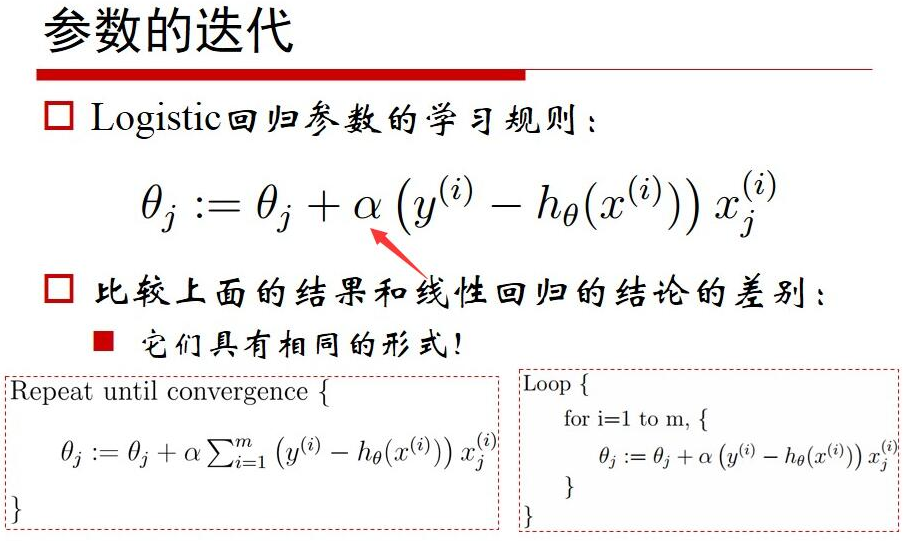
Logistic 代码实现
逻辑实现
from __future__ import print_function
import numpy as np
import matplotlib.pyplot as plt
# Define the logistic function
def logistic(z):
return 1 / (1 + np.exp(-z)) `
# Plot the logistic function
z = np.linspace(-6,6,100)
plt.plot(z, logistic(z), 'b-') // <-- 画图
plt.xlabel('$z$', fontsize=15)
plt.ylabel('$\sigma(z)$', fontsize=15)
plt.title('logistic function')
plt.grid()
plt.show()
Result:

求导实现
# Define the logistic function
def logistic_derivative(z):
return logistic(z) * (1 - logistic(z))

# Plot the derivative of the logistic function
z = np.linspace(-6,6,100)
plt.plot(z, logistic_derivative(z), 'r-') // <-- 画图
plt.xlabel('$z$', fontsize=15)
plt.ylabel('$\\frac{\\partial \\sigma(z)}{\\partial z}$', fontsize=15)
plt.title('derivative of the logistic function')
plt.grid()
plt.show()
Result:
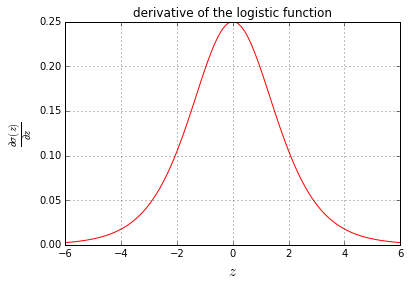
线性多分类
Ref: LogisticRegression(参数解密)
Logistic Regression (aka logit, MaxEnt) classifier.
多分类策略
‘multi_class’ option :
-
- ‘ovr’: one-vs-rest (OvR)
- 'multinomial': cross- entropy loss【it is supported only by the ‘lbfgs’, ‘sag’ and ‘newton-cg’ solvers.】
正则化的参数
参数 penalty
【str, ‘l1’, ‘l2’, ‘elasticnet’ or ‘none’, optional (default=’l2’)】
This class implements regularized logistic regression using the ‘liblinear’ library, ‘newton-cg’, ‘sag’ and ‘lbfgs’ solvers.
参数 solver
【str, {‘newton-cg’, ‘lbfgs’, ‘liblinear’, ‘sag’, ‘saga’}, optional (default=’liblinear’)】
It can handle both dense and sparse input. Use C-ordered arrays or CSR matrices containing 64-bit floats for optimal performance; any other input format will be converted (and copied).
-
- The ‘newton-cg’, ‘sag’, and ‘lbfgs’ solvers support only L2 regularization with primal formulation.
- The ‘liblinear’ solver supports both L1 and L2 regularization, with a dual formulation only for the L2 penalty.
参数 C
【float, default: 1.0】
Inverse of regularization strength; must be a positive float. Like in support vector machines, smaller values specify stronger regularization.
Answer: 参数越小则表明越强的正则化:正则项系数的倒数
参数 multi_class
【str, {‘ovr’, ‘multinomial’}, default: ‘ovr’】
Multiclass option can be either ‘ovr’ or ‘multinomial’. If the option chosen is ‘ovr’, then a binary problem is fit for each label. Else the loss minimised is the multinomial loss fit across the entire probability distribution. Works only for the ‘newton-cg’, ‘sag’ and ‘lbfgs’ solver.
New in version 0.18: Stochastic Average Gradient descent solver for ‘multinomial’ case.
正则化逻辑回归
例一:L1 Penalty and Sparsity in Logistic Regression
# 有点仅一层的logit NN的意思
"""
==============================================
L1 Penalty and Sparsity in Logistic Regression
==============================================
Comparison of the sparsity (percentage of zero coefficients) of solutions when
L1 and L2 penalty are used for different values of C. We can see that large
values of C give more freedom to the model. Conversely, smaller values of C
constrain the model more. In the L1 penalty case, this leads to sparser
solutions.
We classify 8x8 images of digits into two classes: 0-4 against 5-9.
The visualization shows coefficients of the models for varying C.
"""
print(__doc__)
# Authors: Alexandre Gramfort <alexandre.gramfort@inria.fr>
# Mathieu Blondel <mathieu@mblondel.org>
# Andreas Mueller <amueller@ais.uni-bonn.de>
# License: BSD 3 clause
import numpy as np
import matplotlib.pyplot as plt
from sklearn.linear_model import LogisticRegression
from sklearn import datasets
from sklearn.preprocessing import StandardScaler
digits = datasets.load_digits()
X, y = digits.data, digits.target
X = StandardScaler().fit_transform(X)
# 四舍五如
y = (y > 4).astype(np.int)
# Set regularization parameter
for i, C in enumerate((100, 1, 0.01)):
# turn down tolerance for short training time
clf_l1_LR = LogisticRegression(C=C, penalty='l1', tol=0.01)
clf_l2_LR = LogisticRegression(C=C, penalty='l2', tol=0.01)
clf_l1_LR.fit(X, y)
clf_l2_LR.fit(X, y)
coef_l1_LR = clf_l1_LR.coef_.ravel()
coef_l2_LR = clf_l2_LR.coef_.ravel()
# coef_l1_LR contains zeros due to the
# L1 sparsity inducing norm
sparsity_l1_LR = np.mean(coef_l1_LR == 0) * 100
sparsity_l2_LR = np.mean(coef_l2_LR == 0) * 100
print("C=%.2f" % C)
print("Sparsity with L1 penalty: %.2f%%" % sparsity_l1_LR)
print("score with L1 penalty: %.4f" % clf_l1_LR.score(X, y))
print("Sparsity with L2 penalty: %.2f%%" % sparsity_l2_LR)
print("score with L2 penalty: %.4f" % clf_l2_LR.score(X, y))
l1_plot = plt.subplot(3, 2, 2 * i + 1)
l2_plot = plt.subplot(3, 2, 2 * (i + 1))
if i == 0:
l1_plot.set_title("L1 penalty")
l2_plot.set_title("L2 penalty")
l1_plot.imshow(np.abs(coef_l1_LR.reshape(8, 8)), interpolation='nearest', cmap='binary', vmax=1, vmin=0)
l2_plot.imshow(np.abs(coef_l2_LR.reshape(8, 8)), interpolation='nearest', cmap='binary', vmax=1, vmin=0)
plt.text(-8, 3, "C = %.2f" % C)
l1_plot.set_xticks(())
l1_plot.set_yticks(())
l2_plot.set_xticks(())
l2_plot.set_yticks(())
plt.show()
Result:
C=100.00
Sparsity with L1 penalty: 6.25%
score with L1 penalty: 0.9104
Sparsity with L2 penalty: 4.69%
score with L2 penalty: 0.9098
C=1.00
Sparsity with L1 penalty: 9.38%
score with L1 penalty: 0.9098
Sparsity with L2 penalty: 4.69%
score with L2 penalty: 0.9093
C=0.01
Sparsity with L1 penalty: 85.94%
score with L1 penalty: 0.8598
Sparsity with L2 penalty: 4.69%
score with L2 penalty: 0.8915

Jeff:如上,权重的归零化显而易见。
例二:Path with L1- Logistic Regression
print(__doc__)
# Author: Alexandre Gramfort <alexandre.gramfort@inria.fr>
# License: BSD 3 clause
from datetime import datetime
import numpy as np
import matplotlib.pyplot as plt
from sklearn import linear_model
from sklearn import datasets
from sklearn.svm import l1_min_c
iris = datasets.load_iris()
X = iris.data
y = iris.target
X = X[y != 2]
y = y[y != 2]
X -= np.mean(X, 0)
###############################################################################
# Demo path functions
cs = l1_min_c(X, y, loss='log') * np.logspace(0, 3)
# 对正则化的强度取不同值,实验各自效果
print("Computing regularization path ...")
start = datetime.now()
clf = linear_model.LogisticRegression(C=1.0, penalty='l1', tol=1e-6)
coefs_ = []
for c in cs:
clf.set_params(C=c)
clf.fit(X, y)
coefs_.append(clf.coef_.ravel().copy())
print("This took ", datetime.now() - start)
coefs_ = np.array(coefs_)
plt.plot(np.log10(cs), coefs_)
ymin, ymax = plt.ylim()
plt.xlabel('log(C)')
plt.ylabel('Coefficients')
plt.title('Logistic Regression Path')
plt.axis('tight')
plt.show()
系数的变化
coefs_
Out[30]:
array([[ 0. , 0. , 0. , 0. ],
[ 0. , 0. , 0.17813685, 0. ],
[ 0. , 0. , 0.3384641 , 0. ],
...,
[ 0. , -1.29412716, 5.71841258, 0. ],
[ 0. , -1.41538897, 5.82221819, 0. ],
[ 0. , -1.53535948, 5.92878532, 0. ]])
Result:

Jeff:四个系数对应四根线,类似于trace plot,其实还是在说L1, L2的东西。
Softmax 多分类
Ref: Softmax函数解密
Ref: http://www.cnblogs.com/daniel-D/archive/2013/05/30/3109276.html
Ref: http://ufldl.stanford.edu/wiki/index.php/Softmax%E5%9B%9E%E5%BD%92
立体 sigmoid
先来个炫酷的立体sigmoid作为开场:
import numpy as np
import matplotlib.pyplot as plt
from matplotlib import cm
# Define the softmax function
def softmax(z):
return np.exp(z) / np.sum(np.exp(z))
#--------------------------------------------------------------------------
# Plot the softmax output for 2 dimensions for both classes
# Plot the output in function of the weights
# Define a vector of weights for which we want to plot the ooutput
nb_of_zs = 200
zs = np.linspace(-10, 10, num=nb_of_zs) # input
zs_1, zs_2 = np.meshgrid(zs, zs) # generate grid
y = np.zeros((nb_of_zs, nb_of_zs, 2)) # initialize output
# Fill the output matrix for each combination of input z's
for i in range(nb_of_zs):
for j in range(nb_of_zs):
y[i,j,:] = softmax(np.asarray([zs_1[i,j], zs_2[i,j]]))
# Plot the cost function surfaces for both classes
fig = plt.figure()
# Plot the cost function surface for t=1
ax = fig.gca(projection='3d')
surf = ax.plot_surface(zs_1, zs_2, y[:,:,0], linewidth=0, cmap=cm.coolwarm)
ax.view_init(elev=30, azim=70)
cbar = fig.colorbar(surf)
ax.set_xlabel('$z_1$', fontsize=15)
ax.set_ylabel('$z_2$', fontsize=15)
ax.set_zlabel('$y_1$', fontsize=15)
ax.set_title ('$P(t=1|\mathbf{z})$')
cbar.ax.set_ylabel('$P(t=1|\mathbf{z})$', fontsize=15)
plt.grid()
plt.show()
Result:
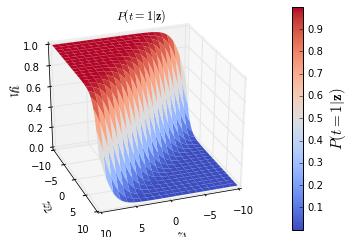
基本原理
在数字手写识别中,我们要识别的是十个类别,每次从输入层输入 28×28 个像素,输出层就可以得到本次输入可能为 0, 1, 2… 的概率。
简易版本的,看起来更直观:

OK, 左边是输入层,输入的 x 通过中间的黑线 w (包含了 bias 项)作用下,得到 w.x, 到达右边节点, 右边节点通过红色的函数将这个值映射成一个概率,预测值就是输入概率最大的节点,这里可能的值是 {0, 1, 2}。
在实现Softmax回归时,将  用一个
用一个  的矩阵来表示会很方便,该矩阵是将
的矩阵来表示会很方便,该矩阵是将  按行罗列起来得到的,如下所示: (k是类别数,n是输入channel数)
按行罗列起来得到的,如下所示: (k是类别数,n是输入channel数)
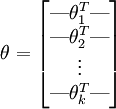
在 softmax regression 中,输入的样本属于第 j 类的概率可以写成:
注意到,这个回归的参数向量减去一个常数向量,会有什么结果:
没有变化!(指数函数的无记忆性)
如果某一个向量是代价函数的极小值点,那么这个向量在减去一个任意的常数向量也是极小值点,这是因为 softmax 模型被过度参数化了。
进一步而言,如果参数  是代价函数
是代价函数  的极小值点,那么
的极小值点,那么  同样也是它的极小值点,其中
同样也是它的极小值点,其中  可以为任意向量。因此使
可以为任意向量。因此使  最小化的解不是唯一的。
最小化的解不是唯一的。
(有趣的是,由于  仍然是一个凸函数,因此梯度下降时不会遇到局部最优解的问题。但是 Hessian 矩阵是奇异的/不可逆的,这会直接导致采用牛顿法优化就遇到数值计算的问题)
仍然是一个凸函数,因此梯度下降时不会遇到局部最优解的问题。但是 Hessian 矩阵是奇异的/不可逆的,这会直接导致采用牛顿法优化就遇到数值计算的问题)
注意,当  时,我们总是可以将
时,我们总是可以将  替换为
替换为 (即替换为全零向量),并且这种变换不会影响假设函数。因此我们可以去掉参数向量
(即替换为全零向量),并且这种变换不会影响假设函数。因此我们可以去掉参数向量  (或者其他
(或者其他  中的任意一个)而不影响假设函数的表达能力。实际上,与其优化全部的
中的任意一个)而不影响假设函数的表达能力。实际上,与其优化全部的  个参数
个参数  (其中
(其中  ),我们可以令
),我们可以令  ,只优化剩余的
,只优化剩余的  个参数,这样算法依然能够正常工作。
个参数,这样算法依然能够正常工作。
在实际应用中,为了使算法实现更简单清楚,往往保留所有参数  ,而不任意地将某一参数设置为 0。但此时我们需要对代价函数做一个改动:加入权重衰减。权重衰减可以解决 softmax 回归的参数冗余所带来的数值问题。
,而不任意地将某一参数设置为 0。但此时我们需要对代价函数做一个改动:加入权重衰减。权重衰减可以解决 softmax 回归的参数冗余所带来的数值问题。
既然模型被过度参数化了,我们就事先确定一个参数,比如将 w1 替换成全零向量,将 w1.x = 0 带入 binomial softmax regression ,得到了我们最开始的二项 logistic regression (可以动手算一算), 用图就可以表示为:
(注:虚线表示为 0 的权重,在第一张图中没有画出来,可以看到 logistic regression 就是 softmax regression 的一种特殊情况)
权重衰减 - 正则化
我们通过添加一个权重衰减项  来修改代价函数(L2原理?),这个衰减项会惩罚过大的参数值,现在我们的代价函数变为:
来修改代价函数(L2原理?),这个衰减项会惩罚过大的参数值,现在我们的代价函数变为:
![\begin{align}J(\theta) = - \frac{1}{m} \left[ \sum_{i=1}^{m} \sum_{j=1}^{k} 1\left\{y^{(i)} = j\right\} \log \frac{e^{\theta_j^T x^{(i)}}}{\sum_{l=1}^k e^{ \theta_l^T x^{(i)} }} \right] + \frac{\lambda}{2} \sum_{i=1}^k \sum_{j=0}^n \theta_{ij}^2\end{align}](http://deeplearning.stanford.edu/wiki/images/math/4/7/1/471592d82c7f51526bb3876c6b0f868d.png)
有了这个权重衰减项以后 ( ),代价函数就变成了严格的凸函数,这样就可以保证得到唯一的解了。 此时的 Hessian矩阵变为可逆矩阵,并且因为
),代价函数就变成了严格的凸函数,这样就可以保证得到唯一的解了。 此时的 Hessian矩阵变为可逆矩阵,并且因为 是凸函数,梯度下降法和 L-BFGS 等算法可以保证收敛到全局最优解。
是凸函数,梯度下降法和 L-BFGS 等算法可以保证收敛到全局最优解。
为了使用优化算法,我们需要求得这个新函数  的导数,如下:
的导数,如下:
![\begin{align}\nabla_{\theta_j} J(\theta) = - \frac{1}{m} \sum_{i=1}^{m}{ \left[ x^{(i)} ( 1\{ y^{(i)} = j\} - p(y^{(i)} = j | x^{(i)}; \theta) ) \right] } + \lambda \theta_j\end{align}](http://deeplearning.stanford.edu/wiki/images/math/3/a/f/3afb4b9181a3063ddc639099bc919197.png)
通过最小化  ,我们就能实现一个可用的 softmax 回归模型。
,我们就能实现一个可用的 softmax 回归模型。
Softmax 回归 vs. k 个二元分类器
如果你在开发一个音乐分类的应用,需要对k种类型的音乐进行识别,那么是选择使用 softmax 分类器呢,还是使用 logistic 回归算法建立 k 个独立的二元分类器呢?
这一选择取决于你的类别之间是否互斥,
-
- 例如,如果你有四个类别的音乐,分别为:古典音乐、乡村音乐、摇滚乐和爵士乐,那么你可以假设每个训练样本只会被打上一个标签(即:一首歌只能属于这四种音乐类型的其中一种),此时你应该使用类别数 k = 4 的softmax回归。(如果在你的数据集中,有的歌曲不属于以上四类的其中任何一类,那么你可以添加一个“其他类”,并将类别数 k 设为5。)
- 如果你的四个类别如下:人声音乐、舞曲、影视原声、流行歌曲,那么这些类别之间并不是互斥的。例如:一首歌曲可以来源于影视原声,同时也包含人声 。这种情况下,使用4个二分类的 logistic 回归分类器更为合适。这样,对于每个新的音乐作品 ,我们的算法可以分别判断它是否属于各个类别。
现在我们来看一个计算视觉领域的例子,你的任务是将图像分到三个不同类别中。
-
- (i) 假设这三个类别分别是:室内场景、户外城区场景、户外荒野场景。你会使用sofmax回归还是 3个logistic 回归分类器呢? —— 三个类别是互斥的,因此更适于选择softmax回归分类器 。
- (ii) 现在假设这三个类别分别是室内场景、黑白图片、包含人物的图片,你又会选择 softmax 回归还是多个 logistic 回归分类器呢?—— 建立三个独立的 logistic回归分类器更加合适。
例三: Plot multinomial and One-vs-Rest Logistic Regression
"""
====================================================
Plot multinomial and One-vs-Rest Logistic Regression
====================================================
Plot decision surface of multinomial and One-vs-Rest Logistic Regression.
The hyperplanes corresponding to the three One-vs-Rest (OVR) classifiers
are represented by the dashed lines.
"""
print(__doc__)
# Authors: Tom Dupre la Tour <tom.dupre-la-tour@m4x.org>
# License: BSD 3 clause
import numpy as np
import matplotlib.pyplot as plt
from sklearn.datasets import make_blobs
from sklearn.linear_model import LogisticRegression
# make 3-class dataset for classification
centers = [[-5, 0], [0, 1.5], [5, -1]]
X, y = make_blobs(n_samples=1000, centers=centers, random_state=40)
transformation = [[0.4, 0.2], [-0.4, 1.2]]
X = np.dot(X, transformation)
for multi_class in ('', 'ovr'):
clf = LogisticRegression(solver='sag', max_iter=100, random_state=42, multi_class=multi_class).fit(X, y)
# print the training scores
print("training score : %.3f (%s)" % (clf.score(X, y), multi_class))
# create a mesh to plot in
h = .02 # step size in the mesh
x_min, x_max = X[:, 0].min() - 1, X[:, 0].max() + 1
y_min, y_max = X[:, 1].min() - 1, X[:, 1].max() + 1
xx, yy = np.meshgrid(np.arange(x_min, x_max, h), np.arange(y_min, y_max, h))
# Plot the decision boundary. For that, we will assign a color to each
# point in the mesh [x_min, x_max]x[y_min, y_max].
Z = clf.predict(np.c_[xx.ravel(), yy.ravel()])
# Put the result into a color plot
Z = Z.reshape(xx.shape)
plt.figure()
plt.contourf(xx, yy, Z, cmap=plt.cm.Paired)
plt.title("Decision surface of LogisticRegression (%s)" % multi_class)
plt.axis('tight')
# Plot also the training points
colors = "bry"
for i, color in zip(clf.classes_, colors):
idx = np.where(y == i)
plt.scatter(X[idx, 0], X[idx, 1], c=color, cmap=plt.cm.Paired)
# Plot the three one-against-all classifiers
xmin, xmax = plt.xlim()
ymin, ymax = plt.ylim()
coef = clf.coef_
intercept = clf.intercept_
def plot_hyperplane(c, color):
def line(x0):
return (-(x0 * coef[c, 0]) - intercept[c]) / coef[c, 1]
plt.plot([xmin, xmax], [line(xmin), line(xmax)],
ls="--", color=color)
for i, color in zip(clf.classes_, colors):
plot_hyperplane(i, color)
plt.show()
Result:

Jeff:可见multinomial是正确的选择。
End.





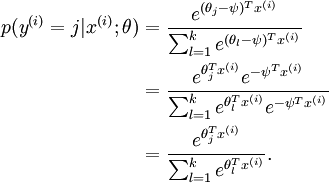


 浙公网安备 33010602011771号
浙公网安备 33010602011771号